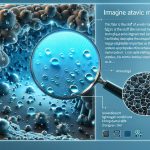Are you ready to be amazed by the latest breakthroughs in textile technology?
The fabric revolution is here, and it’s bringing self-cleaning fabrics, smart textiles for health monitoring, sustainable materials, enhanced performance fabrics, interactive and responsive fabrics, and advanced manufacturing techniques.
Get ready to experience a whole new level of comfort, convenience, and innovation in the world of textiles.
The future is now, and it’s all about revolutionizing the way we wear and interact with fabrics.
Table of Contents
Self-Cleaning Fabrics
You can now experience the convenience of self-cleaning fabrics, a revolutionary breakthrough in textile technology. Thanks to nanotechnology applications and their antimicrobial properties, these fabrics are designed to keep themselves clean and fresh with minimal effort on your part.
Gone are the days of constantly washing and treating your clothes to remove stains and odors. With self-cleaning fabrics, dirt and grime are unable to cling to the surface, making them easy to wipe clean or simply shake off. The secret lies in the microscopic nanoparticles embedded within the fabric, which repel dirt and prevent bacteria from multiplying, thus reducing the need for frequent washing.
Not only do self-cleaning fabrics save you time and effort, but they also have the added benefit of being more hygienic. By inhibiting the growth of bacteria, these fabrics help maintain a cleaner and healthier environment, especially for those with sensitive skin or allergies.
Imagine never having to worry about spills or stains ruining your favorite clothes again. With self-cleaning fabrics, you can confidently go about your day knowing that your garments will stay fresh and clean, no matter what you encounter.
Embrace the convenience of self-cleaning fabrics and revolutionize your wardrobe today.
Smart Textiles for Health Monitoring
Get ready to revolutionize your healthcare routine with the latest advancements in smart textiles.
With wearable health sensors integrated into fabrics, you can now monitor your health in real-time, right from your clothes.
Gone are the days of traditional patient monitoring methods – these smart textiles provide improved accuracy and convenience, making healthcare more accessible and efficient than ever before.
Wearable Health Sensors
With advancements in textile technology, monitoring your health through wearable sensors has become possible. Smart clothing equipped with remote monitoring capabilities allows for continuous tracking of vital signs and other health metrics. These innovative wearables are designed to seamlessly integrate into your daily routine, providing real-time data about your well-being. By incorporating sensors into the fabric, smart textiles can measure heart rate, blood pressure, body temperature, and even detect abnormal patterns or potential health risks. This information can be wirelessly transmitted to a smartphone or other devices, enabling healthcare professionals to remotely monitor your health and provide timely interventions if necessary. Wearable health sensors offer a convenient and non-invasive way to stay proactive about your well-being, empowering you to take control of your health and make informed decisions.
| Advantages | Limitations |
|---|---|
| Continuous monitoring of vital signs | Limited accuracy compared to medical-grade devices |
| Real-time data collection and analysis | Limited battery life |
| Enables remote health monitoring | Limited range of health metrics |
| Convenient and non-invasive | Limited availability and high cost |
| Empowers individuals to take control of their health | Privacy and security concerns |
Real-Time Health Data
Continuing the exploration of wearable health sensors, the fabric revolution now introduces real-time health data through smart textiles for continuous monitoring of vital signs and other health metrics. This advancement in textile technology allows for a seamless integration of wearable fitness devices into everyday clothing, making it easier than ever to track your health on the go.
Here are three key benefits of real-time health data and smart textiles:
-
Improved Accuracy: Smart textiles enable precise and accurate monitoring of vital signs such as heart rate, respiratory rate, and body temperature. This ensures that you receive reliable and up-to-date information about your health status.
-
Enhanced Convenience: With smart textiles, there’s no need for additional devices or cumbersome equipment. The sensors are seamlessly integrated into the fabric, allowing for discreet and effortless health monitoring.
-
Remote Monitoring: Real-time health data can be transmitted wirelessly to healthcare professionals, enabling remote monitoring and timely intervention. This is particularly beneficial for individuals with chronic conditions or those who require continuous monitoring.
With real-time health data and smart textiles, the fabric revolution brings us one step closer to a future where our clothing not only reflects our style but also helps us stay healthy.
Improved Patient Monitoring
Experience enhanced patient monitoring with the use of smart textiles for health monitoring. These innovative textiles have the ability to revolutionize patient care by enabling remote monitoring and providing personalized care.
With smart textiles, healthcare professionals can remotely monitor patients’ vital signs, such as heart rate, blood pressure, and body temperature, in real-time. This allows for early detection of any abnormalities or changes in the patient’s health, ensuring timely interventions and preventing potential complications.
Moreover, smart textiles can be customized to the individual patient’s needs, providing personalized care and tailored treatment plans.
By incorporating smart textiles into patient monitoring, healthcare providers can improve the quality of care, enhance patient safety, and optimize healthcare resources.
The future of patient monitoring lies in these intelligent textiles, bringing us closer to a more connected and efficient healthcare system.
Sustainable and Eco-Friendly Materials
You can now find sustainable and eco-friendly materials in the latest breakthroughs of textile tech. As the world becomes more conscious of the environmental impact of the fashion industry, designers and engineers are developing innovative solutions to create fabrics that are both fashionable and sustainable. Here are three exciting developments in sustainable and eco-friendly materials:
-
Biodegradable fibers: Traditional fabrics are often made from synthetic materials that take hundreds of years to decompose. However, with the advancement of textile technology, biodegradable fibers are now being used to create fabrics that can break down naturally, reducing waste and pollution. These fibers are usually derived from natural sources such as plants and can be recycled or composted at the end of their lifecycle.
-
Renewable textiles: In the quest for sustainability, renewable textiles are gaining popularity. These textiles are made from renewable resources, such as organic cotton, hemp, or bamboo, which require less water and energy to produce compared to conventional materials. By using renewable textiles, we can reduce our reliance on non-renewable resources and minimize the carbon footprint of the textile industry.
-
Sustainable dyeing techniques: The process of dyeing fabrics has long been associated with environmental pollution due to the use of toxic chemicals. However, textile tech breakthroughs have led to the development of sustainable dyeing techniques that use natural dyes derived from plants and minerals. These eco-friendly dyeing methods not only reduce water pollution but also create vibrant and long-lasting colors.
Enhanced Performance Fabrics
Developing fabrics with enhanced performance capabilities is a key focus in the latest breakthroughs of textile tech. Manufacturers are constantly exploring new ways to improve the functionality and comfort of fabrics, and two important areas of development are bio-based materials and moisture-wicking fabrics.
Bio-based materials are gaining popularity due to their sustainable and eco-friendly nature. These materials are derived from renewable resources such as plants, and they offer several advantages over traditional fabrics. Not only are they biodegradable, reducing the environmental impact, but they also have natural properties that enhance performance. For example, bio-based materials can be naturally antibacterial, odor-resistant, and UV-protective, making them ideal for activewear and outdoor apparel.
Moisture-wicking fabrics, on the other hand, are designed to draw moisture away from the body, keeping you dry and comfortable during physical activities. These fabrics have special fibers or treatments that allow them to quickly absorb and evaporate sweat, preventing the build-up of moisture and reducing the risk of chafing and discomfort. Moisture-wicking fabrics are commonly used in sportswear, workout gear, and undergarments.
To give you a better understanding of the enhanced performance capabilities of these fabrics, take a look at the table below:
| Fabric Type | Benefits |
|---|---|
| Bio-based | Biodegradable, antibacterial, odor-resistant, UV-protective |
| Moisture-wicking | Quick-drying, sweat absorption, chafe prevention |
Interactive and Responsive Fabrics
Are you ready to discover the future of fabrics? Get ready to be amazed by the world of interactive and responsive textiles. These fabrics aren’t just ordinary materials – they’re smart, innovative, and capable of transforming the way we interact with our clothing and our environment.
Get ready to explore the exciting applications of smart textiles and envision a future where your clothes can do much more than just cover your body.
Smart Textile Applications
Experience the future of fabrics with interactive and responsive smart textile applications. Smart clothing has revolutionized the textile industry, pushing the boundaries of innovation and functionality.
Here are three exciting applications of smart textiles:
-
Health Monitoring: Smart textiles embedded with sensors can monitor vital signs such as heart rate, body temperature, and breathing patterns. These garments can provide real-time data to healthcare professionals, enabling remote patient monitoring and early detection of health issues.
-
Climate Control: Imagine wearing a fabric that adjusts its temperature according to your surroundings. Smart textiles can regulate body heat through embedded thermoelectric materials, keeping you comfortable in any weather conditions.
-
Gesture Recognition: Smart textiles can detect and interpret gestures, allowing users to control devices with simple hand movements. This technology opens up new possibilities for intuitive human-computer interaction, making our daily lives more convenient and efficient.
With these advancements in smart textile applications, the future of clothing is becoming increasingly interactive and responsive.
Future of Interactive Fabrics
You can expect a future where interactive and responsive fabrics will revolutionize the way you experience clothing.
The development of wearable fashion and smart clothing is paving the way for this exciting new technology.
Imagine a jacket that can adjust its temperature based on your body’s needs, or a dress that changes color with a touch.
These interactive fabrics won’t only enhance your style but also provide practical benefits.
For example, sensors embedded in the fabric can monitor your heart rate and alert you if there are any irregularities.
Additionally, interactive fabrics can be programmed to provide haptic feedback, allowing you to feel textures and patterns through your clothing.
The possibilities are endless, and the future of interactive fabrics is set to transform the way we interact with our garments.
Advanced Manufacturing Techniques
Discover the cutting-edge advancements in textile manufacturing techniques that are revolutionizing the industry. Here are three ways that digital integration and additive manufacturing are transforming the way fabrics are made:
-
Digital Integration:
With the integration of digital technologies, textile manufacturers can now streamline their production processes. Sophisticated software and automation systems enable precise control over every stage of manufacturing, from design to production. This digital integration allows for increased efficiency, reduced waste, and faster production times. Manufacturers can now easily create intricate patterns and designs on fabrics using computer programs, eliminating the need for manual labor and reducing the chance of errors. -
Additive Manufacturing:
Additive manufacturing, also known as 3D printing, has made significant strides in the textile industry. This technique allows manufacturers to create complex shapes and structures using layers of material. By building up the fabric layer by layer, additive manufacturing opens up new possibilities for creating innovative and unique textiles. It also allows for customization, as fabrics can be tailored to individual customer needs. Additive manufacturing has the potential to revolutionize the fashion industry by enabling designers to bring their ideas to life quickly and efficiently. -
Smart Fabrics:
Advanced manufacturing techniques have also paved the way for the development of smart fabrics. These fabrics are embedded with sensors, microchips, and other electronic components that can monitor and respond to changes in the environment. Smart fabrics are being used in various applications, such as medical textiles that can monitor patients’ vital signs and athletic wear that can track athletes’ performance. The integration of digital technologies with textiles has the potential to create a new generation of functional fabrics that can enhance our daily lives.
Frequently Asked Questions
What Are the Potential Applications of Self-Cleaning Fabrics Beyond Clothing?
You can find potential applications of self-cleaning fabrics beyond clothing in smart textiles for home decor. Additionally, the automotive industry can benefit from the use of these fabrics for various applications.
How Do Smart Textiles for Health Monitoring Work and What Kind of Data Can They Collect?
Smart textiles for health monitoring work by integrating sensors into the fabric, collecting data on vital signs like heart rate and temperature. They can help track health conditions and provide real-time feedback, revolutionizing healthcare.
What Are Some Innovative Methods Used in the Production of Sustainable and Eco-Friendly Materials for Textiles?
Innovative methods for producing sustainable and eco-friendly materials for textiles include using bio-based textiles made from natural resources and utilizing 3D printing technology to create intricate and customizable designs.
How Do Enhanced Performance Fabrics Improve Comfort and Durability?
Enhanced performance fabrics improve your comfort and durability. These fabrics are designed to provide better functionality, such as moisture-wicking and temperature regulation, while maintaining their strength and longevity.
Can You Provide Examples of Interactive and Responsive Fabrics and Their Uses in Different Industries?
Interactive fabrics and responsive textiles are transforming various industries. These innovative materials can be used in healthcare for smart bandages that monitor healing progress or in sports for clothing that adjusts temperature based on activity levels.
- The Use of Nonwovens in Construction and Civil Engineering - July 11, 2025
- The Use of Nonwovens in Construction and Civil Engineering - July 11, 2025
- The Use of Nonwovens in Construction and Civil Engineering - July 11, 2025





